Evaluation of Areal Monthly Average Precipitation Estimates from MERRA2 and ERA5 Reanalysis in a Colombian Caribbean Basin
Abstract
:1. Introduction
2. Materials and Methods
2.1. Study Area
2.2. Datasets
2.2.1. Observed Rainfall
2.2.2. MERRA2
2.2.3. ERA5
2.3. Method
- NRMSE: The normalized version of the root mean square error (RMSE) in terms of the average of measured data allows datasets to be compared with different scales and provides a better idea of the reliability of the reanalysis datasets [39]. When NRMSE < 0.50, the estimations are deemed reliable. On the other hand, an NRMSE ≥ 0.50 denotes unreliable estimates for the corresponding region and season [60]. NRMSE values range from 0.00 to +∞.
- ρS: The simple definition for correlation coefficients is that they are metrics that quantify the strength of the linear association between two bivariate variables—in our case, reanalysis rainfall and observed rainfall. Correlation measures the degree to which a change in one variable tends to match a shift in the other [63]. The Spearman’s rank correlation coefficient (ρS), also known as the Spearman’s Rho, can be defined as similar to the Pearson correlation (or simple correlation), although it uses the ranks instead of the actual values. This modification allows the relationship between two variables that do not follow a normal distribution or are affected by extreme values to be assessed, such as the time series employed in this research. The ρS values of −1.00, 0.00, and +1.00 indicate that reanalysis and observed rainfall are negatively, poorly, and positively correlated, respectively [39].
- NSE: This normalized statistic quantifies the relative magnitude of the residual variance, or mean square error, compared to the measured data variance (IDEAM observations) [61,64]. An NSE = 1 would imply a perfect match between estimates and observed rainfall. An NSE value of 0 indicates that the estimations are only as good as the mean of the observations, while negative NSE values denote a poor match between the datasets, indicating that the mean square error between measurements and estimates is higher than the mean of the measurement dataset [39,63].
3. Results
3.1. Complete Sinú River Basin
3.2. Upper Sinú River Basin
3.3. Middle Sinú River Basin
3.4. Lower Sinú River Basin
4. Discussion
5. Conclusions
Author Contributions
Funding
Institutional Review Board Statement
Informed Consent Statement
Data Availability Statement
Acknowledgments
Conflicts of Interest
Appendix A. IDEAM Stations and Thiessen Polygons
| Station Name [IDEAM CODE] | Latitude (Degrees) | Longitude (Degrees) | Elevation (masl) | Thiessen Polygon Area (km2) | Area in Lower Sinú (%) | Area in Middle Sinú (%) | Area in Upper Sinú (%) |
|---|---|---|---|---|---|---|---|
| AEROPUERTO LOS GARZONES [13035501] | 8.826 | −75.825 | 20 | 25.918 | 100 | ||
| AGUAS MOHOSAS [13070450] | 9.251 | −75.492 | 75 | 76.958 | 100 | ||
| BOCA DE LA CEIBA [13070070] | 8.830 | −75.856 | 20 | 90.732 | 100 | ||
| BUENOS AIRES [13060020] | 8.476 | −75.765 | 55 | 314.776 | 100 | ||
| BUENOS AIRES 1 [13070170] | 8.773 | −75.750 | 9 | 56.499 | 100 | ||
| CALLEMAR [13070120] | 8.698 | −75.678 | 95 | 128.330 | 100 | ||
| CAMPO BELLO [13015030] | 7.983 | −76.233 | 78 | 3972.089 | 0.59 | 99.41 | |
| CARAMELO [13060030] | 8.266 | −75.904 | 60 | 459.341 | 100 | ||
| CARRILLO [13070180] | 8.984 | −75.832 | 20 | 385.131 | 100 | ||
| CARRIZAL [13070110] | 8.682 | −75.754 | 40 | 111.282 | 99.91 | 0.09 | |
| CENTRO ALEGRE [25015010] | 8.181 | −75.632 | 170 | 99.290 | 100 | ||
| CERETE [13070050] | 8.890 | −75.786 | 20 | 94.646 | 100 | ||
| CHIMA [13075010] | 9.151 | −75.622 | 20 | 319.723 | 100 | ||
| CHINU—AUT [25020470] | 9.118 | −75.393 | 125 | 87.128 | 100 | ||
| CIENAGA DE ORO [13077070] | 8.873 | −75.626 | 10 | 144.375 | 100 | ||
| COLOMBOY [25025170] | 8.741 | −75.499 | 125 | 51.013 | 100 | ||
| COROZA 2 [13070190] | 8.805 | −75.765 | 9 | 45.094 | 100 | ||
| CRISTO REY—AUT [12045020] | 9.071 | −76.224 | 15 | 3.249 | 100 | ||
| DOCTRINA LA [13080060] | 9.300 | −75.883 | 4 | 467.361 | 100 | ||
| GALAN [13055030] | 8.659 | −75.973 | 30 | 372.649 | 55.84 | 44.16 | |
| LIMON EL [13070010] | 9.336 | −75.938 | 3 | 187.366 | 100 | ||
| LOMA VERDE [13050030] | 8.502 | −76.175 | 100 | 407.425 | 54.27 | 45.73 | |
| MARACAYO [13065020] | 8.411 | −75.884 | 25 | 426.375 | 0.01 | 99.99 | |
| MOMIL [13070020] | 9.234 | −75.688 | 20 | 328.587 | 100 | ||
| PEZVAL [13040030] | 8.262 | −76.169 | 80 | 641.702 | 100 | ||
| PLANETA RICA—AUT [25025190] | 8.399 | −75.584 | 90 | 66.321 | 100 | ||
| PUERTO LIBERTADOR [25010010] | 7.890 | −75.680 | 55 | 216.258 | 100 | ||
| RABOLARGO [13070040] | 8.951 | −75.742 | 19 | 228.119 | 100 | ||
| REPRESA URRA [13015040] | 8.014 | −76.203 | 300 | 675.751 | 55.47 | 44.53 | |
| SABANAL [13070280] | 8.789 | −75.751 | 10 | 13.320 | 100 | ||
| SAHAGUN [25020140] | 8.951 | −75.452 | 60 | 147.691 | 100 | ||
| SAJONIA HACIENDA—AUT [25020600] | 8.490 | −75.601 | 100 | 22.326 | 0.01 | 99.99 | |
| SALADO EL [13075020] | 8.914 | −75.582 | 40 | 238.833 | 100 | ||
| SAN ANTERITO [13060010] | 8.558 | −75.861 | 75 | 261.556 | 1.94 | 98.06 | |
| SAN ANTONIO [13080010] | 8.936 | −75.953 | 50 | 342.045 | 100 | ||
| SAN BERNARDO [13085030] | 9.371 | −75.949 | 22 | 74.134 | 100 | ||
| SAN CARLOS [13070090] | 8.791 | −75.701 | 60 | 93.644 | 100 | ||
| SAN FRANCISCO [25010100] | 8.129 | −75.760 | 160 | 259.788 | 100 | ||
| SANTA CRUZ HACIENDA [13050020] | 8.668 | −76.124 | 220 | 218.157 | 100 | ||
| SANTA LUCIA [13050010] | 8.849 | −76.045 | 120 | 258.157 | 100 | ||
| SANTA ROSA [13070100] | 8.741 | −75.601 | 140 | 120.803 | 100 | ||
| TAMPA [13070290] | 8.625 | −75.767 | 20 | 181.126 | 75.67 | 24.33 | |
| TIERRALTA [13030010] | 8.187 | −76.053 | 100 | 559.329 | 99.66 | 0.34 | |
| TREMENTINO [25021210] | 8.818 | −75.474 | 136 | 62.723 | 100 | ||
| TURIPANA [13075030] | 8.840 | −75.802 | 20 | 31.465 | 100 | ||
| UNIV DE CORDOBA [13075050] | 8.794 | −75.862 | 15 | 172.213 | 100 | ||
| URE [25010060] | 7.788 | −75.538 | 200 | 119.650 | 100 | ||
| VENECIA [13070430] | 9.195 | −75.541 | 50 | 186.400 | 100 | ||
| VILLA MARCELA [13070440] | 9.352 | −75.719 | 40 | 85.684 | 100 |
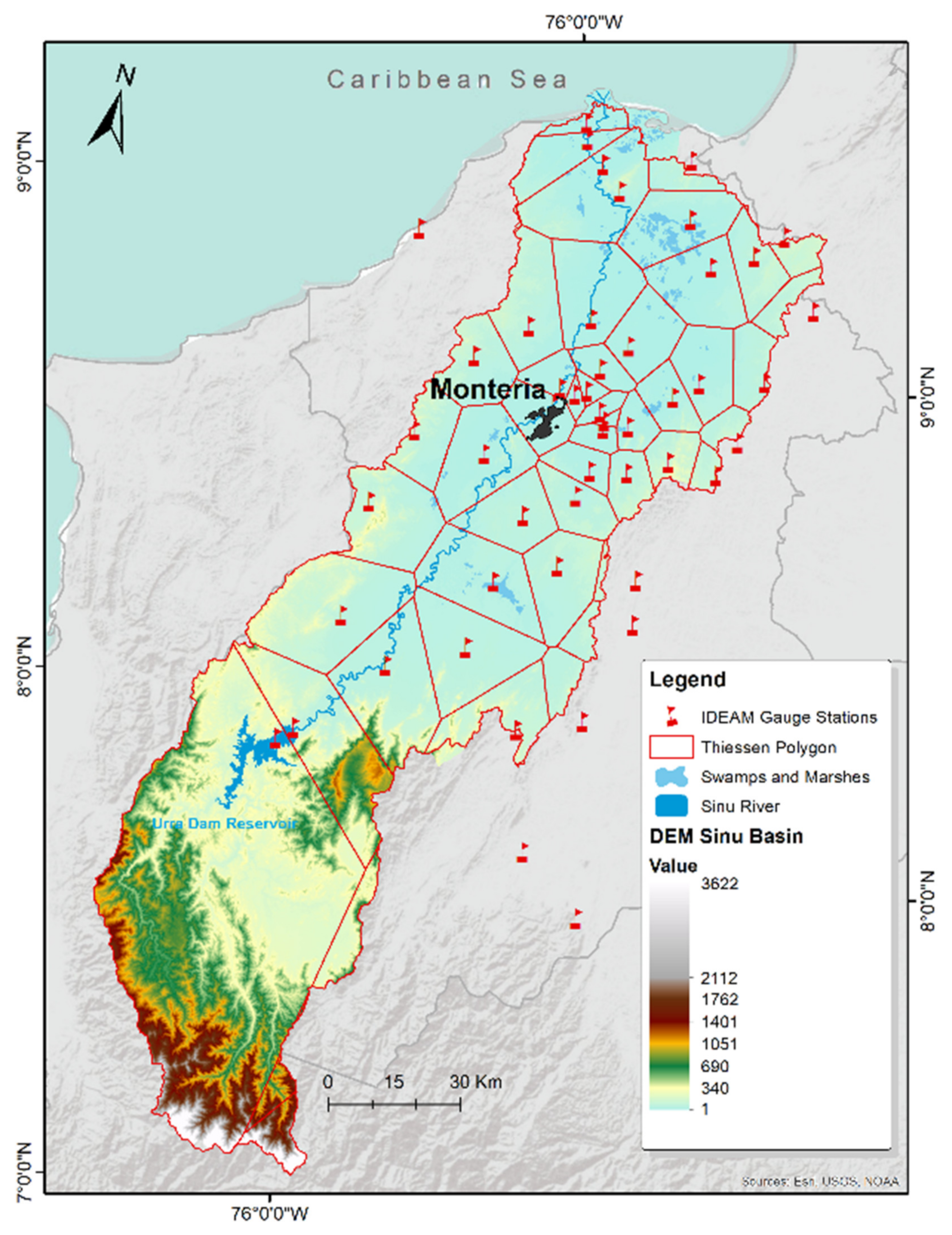
References
- Bertoni, J.C.; Tucci, C.E.M. Precipitação. In Hidrologia: Ciência e Aplicação; Tucci, C.E.M., Ed.; Editora da UFRGS/ABRH: Porto Alegre, Brazil, 2004; pp. 177–241. ISBN 8570256639. [Google Scholar]
- Canales, F.A.; Gwoździej-Mazur, J.; Jadwiszczak, P.; Struk-Sokołowska, J.; Wartalska, K.; Wdowikowski, M.; Kaźmierczak, B. Long-Term Trends in 20-Day Cumulative Precipitation for Residential Rainwater Harvesting in Poland. Water 2020, 12, 1932. [Google Scholar] [CrossRef]
- Nkiaka, E.; Nawaz, N.R.; Lovett, J.C. Evaluating global reanalysis precipitation datasets with rain gauge measurements in the Sudano-Sahel region: Case study of the Logone catchment, Lake Chad Basin. Meteorol. Appl. 2017, 24, 9–18. [Google Scholar] [CrossRef]
- Lozano Sandoval, G.; Monsalve Durango, E.A.; García Reinoso, P.L.; Rodríguez Mejía, C.A.; Gómez Ospina, J.P.; Triviño Loaiza, H.J. Environmental Flow Estimation Using Hydrological and Hydraulic Methods for the Quindío River Basin: WEAP as a Support Tool. Inge CUC 2015, 11, 34–48. [Google Scholar] [CrossRef] [Green Version]
- Dingman, S.L. Physical Hydrology, 3rd ed.; Waveland Press, Inc.: Long Grove, IL, USA, 2015; ISBN 9781478611189. [Google Scholar]
- World Meteorological Organization. Guide to Hydrological Practice. Volume I: Hydrology—From Measurement to Hydrological Information; World Meteorological Organization: Geneva, Switzerland, 2008; ISBN 9789263101686. [Google Scholar]
- Condom, T.; Martínez, R.; Pabón, J.D.; Costa, F.; Pineda, L.; Nieto, J.J.; López, F.; Villacis, M. Climatological and Hydrological Observations for the South American Andes: In situ Stations, Satellite, and Reanalysis Data Sets. Front. Earth Sci. 2020, 8, 1–20. [Google Scholar] [CrossRef] [Green Version]
- Yu, Z.; Wu, J.; Chen, X. An approach to revising the climate forecast system reanalysis rainfall data in a sparsely-gauged mountain basin. Atmos. Res. 2019, 220, 194–205. [Google Scholar] [CrossRef]
- Thornton, P.E.; Running, S.W.; White, M.A. Generating surfaces of daily meteorological variables over large regions of complex terrain. J. Hydrol. 1997, 190, 214–251. [Google Scholar] [CrossRef] [Green Version]
- Ramirez Camargo, L.; Gruber, K.; Nitsch, F. Assessing variables of regional reanalysis data sets relevant for modelling small-scale renewable energy systems. Renew. Energy 2019, 133, 1468–1478. [Google Scholar] [CrossRef]
- Chawla, I.; Mujumdar, P.P. Evaluating rainfall datasets to reconstruct floods in data-sparse Himalayan region. J. Hydrol. 2020, 588, 125090. [Google Scholar] [CrossRef]
- Sun, S.; Shi, W.; Zhou, S.; Chai, R.; Chen, H.; Wang, G.; Zhou, Y.; Shen, H. Capacity of satellite-based and reanalysis precipitation products in detecting long-term trends across Mainland China. Remote Sens. 2020, 12, 2902. [Google Scholar] [CrossRef]
- Blacutt, L.A.; Herdies, D.L.; de Gonçalves, L.G.G.; Vila, D.A.; Andrade, M. Precipitation comparison for the CFSR, MERRA, TRMM3B42 and Combined Scheme datasets in Bolivia. Atmos. Res. 2015, 163, 117–131. [Google Scholar] [CrossRef] [Green Version]
- Bojanowski, J.S.; Vrieling, A.; Skidmore, A.K. A comparison of data sources for creating a long-term time series of daily gridded solar radiation for Europe. Sol. Energy 2014, 99, 152–171. [Google Scholar] [CrossRef]
- Dee, D.; Fasullo, J.; Shea, D.; Walsh, J. National Center for Atmospheric Research The Climate Data Guide: Atmospheric Reanalysis: Overview & Comparison Tables. Available online: https://climatedataguide.ucar.edu/climate-data/atmospheric-reanalysis-overview-comparison-tables (accessed on 6 June 2021).
- Hersbach, H.; Bell, B.; Berrisford, P.; Hirahara, S.; Horányi, A.; Muñoz-Sabater, J.; Nicolas, J.; Peubey, C.; Radu, R.; Schepers, D.; et al. The ERA5 global reanalysis. Q. J. R. Meteorol. Soc. 2020, 146, 1999–2049. [Google Scholar] [CrossRef]
- Springer, A.; Eicker, A.; Bettge, A.; Kusche, J.; Hense, A.; Mahto, S.S.; Pandey, A.C.; Huang, B.; Cubasch, U.; Li, Y.; et al. Evaluation of the Water Cycle in the European COSMO-REA6 Reanalysis Using GRACE. Water 2017, 9, 289. [Google Scholar] [CrossRef]
- Nguyen, T.H.; Masih, I.; Mohamed, Y.A.; van der Zaag, P. Validating rainfall-runoff modelling using satellite-based and reanalysis precipitation products in the sre pok catchment, the mekong river basin. Geosciences 2018, 8, 164. [Google Scholar] [CrossRef] [Green Version]
- Jurasz, J.; Canales, F.A.; Kies, A.; Guezgouz, M.; Beluco, A. A review on the complementarity of renewable energy sources: Concept, metrics, application and future research directions. Sol. Energy 2020, 195, 703–724. [Google Scholar] [CrossRef]
- Ramirez Camargo, L.; Schmidt, J. Simulation of multi-annual time series of solar photovoltaic power: Is the ERA5-land reanalysis the next big step? Sustain. Energy Technol. Assess. 2020, 42, 100829. [Google Scholar] [CrossRef]
- Canales, F.A.; Jurasz, J.K.; Guezgouz, M.; Beluco, A. Cost-reliability analysis of hybrid pumped-battery storage for solar and wind energy integration in an island community. Sustain. Energy Technol. Assess. 2021, 44, 101062. [Google Scholar]
- Kapica, J.; Canales, F.A.; Jurasz, J. Global atlas of solar and wind resources temporal complementarity. Energy Convers. Manag. 2021, 246, 114692. [Google Scholar] [CrossRef]
- Hurtado-Montoya, A.F.; Mesa-Sánchez, Ó.J. Reanalysis of monthly precipitation fields in Colombian territory. Dyna 2014, 81, 251. [Google Scholar] [CrossRef]
- Dinku, T.; Funk, C.; Peterson, P.; Maidment, R.; Tadesse, T.; Gadain, H.; Ceccato, P. Validation of the CHIRPS satellite rainfall estimates over eastern Africa. Q. J. R. Meteorol. Soc. 2018, 144, 292–312. [Google Scholar] [CrossRef] [Green Version]
- Urrea, V.; Ochoa, A.; Mesa, O. Seasonality of Rainfall in Colombia. Water Resour. Res. 2019, 55, 4149–4162. [Google Scholar] [CrossRef]
- Fernandes, K.; Muñoz, A.G.; Ramirez-Villegas, J.; Agudelo, D.; Llanos-Herrera, L.; Esquivel, A.; Rodriguez-Espinoza, J.; Prager, S.D. Improving seasonal precipitation forecasts for agriculture in the orinoquía Region of Colombia. Weather Forecast. 2020, 35, 437–449. [Google Scholar] [CrossRef]
- Urrea, V.; Ochoa, A.; Mesa, O. Validación de la base de datos de precipitación CHIRPS para Colombia a escala diaria, mensual y anual en el período 1981–2014. In Proceedings of the XXVII Congreso Latinoamericano de Hidráulica, Lima, Peru, 28–30 September 2016; p. 11. [Google Scholar]
- Morales-Acuña, E.; Linero-Cueto, J.R.; Canales, F.A. Assessment of Precipitation Variability and Trends Based on Satellite Estimations for a Heterogeneous Colombian Region. Hydrology 2021, 8, 128. [Google Scholar] [CrossRef]
- Funk, C.; Peterson, P.; Landsfeld, M.; Pedreros, D.; Verdin, J.; Shukla, S.; Husak, G.; Rowland, J.; Harrison, L.; Hoell, A.; et al. The climate hazards infrared precipitation with stations—A new environmental record for monitoring extremes. Sci. Data 2015, 2, 1–21. [Google Scholar] [CrossRef] [PubMed] [Green Version]
- Jurasz, J.; Beluco, A.; Canales, F.A. The impact of complementarity on power supply reliability of small scale hybrid energy systems. Energy 2018, 161, 737–743. [Google Scholar] [CrossRef]
- Canales, F.A.; Jurasz, J.; Kies, A.; Beluco, A.; Arrieta-Castro, M.; Peralta-Cayón, A. Spatial representation of temporal complementarity between three variable energy sources using correlation coefficients and compromise programming. MethodsX 2020, 7, 100871. [Google Scholar] [CrossRef] [PubMed]
- Canales, F.A.; Jurasz, J.; Beluco, A.; Kies, A. Assessing temporal complementarity between three variable energy sources through correlation and compromise programming. Energy 2020, 192, 116637. [Google Scholar] [CrossRef] [Green Version]
- Copernicus Climate Change Service (C3S) ERA5: Fifth Generation of ECMWF Atmospheric Reanalyses of the Global Climate. Available online: https://cds.climate.copernicus.eu/cdsapp#!/home (accessed on 25 May 2021).
- National Aeronautics and Space Administration Goddard Earth Sciences Data and Information Services Center (GES DISC). Available online: https://disc.gsfc.nasa.gov/datasets?project=MERRA-2 (accessed on 11 November 2020).
- Quagraine, K.A.; Nkrumah, F.; Klein, C.; Klutse, N.A.B.; Quagraine, K.T. West African summer monsoon precipitation variability as represented by reanalysis datasets. Climate 2020, 8, 111. [Google Scholar] [CrossRef]
- Zandler, H.; Haag, I.; Samimi, C. Evaluation needs and temporal performance differences of gridded precipitation products in peripheral mountain regions. Sci. Rep. 2019, 9, 15118. [Google Scholar] [CrossRef] [Green Version]
- Huang, L.; Mo, Z.; Liu, L.; Zeng, Z.; Chen, J.; Xiong, S.; He, H. Evaluation of Hourly PWV Products Derived From ERA5 and MERRA-2 Over the Tibetan Plateau Using Ground-Based GNSS Observations by Two Enhanced Models. Earth Space Sci. 2021, 8, e2020EA001516. [Google Scholar]
- Mahto, S.S.; Mishra, V. Does ERA-5 Outperform Other Reanalysis Products for Hydrologic Applications in India? J. Geophys. Res. Atmos. 2019, 124, 9423–9441. [Google Scholar] [CrossRef]
- Lemma, E.; Upadhyaya, S.; Ramsankaran, R.A.A.J. Investigating the performance of satellite and reanalysis rainfall products at monthly timescales across different rainfall regimes of Ethiopia. Int. J. Remote Sens. 2019, 40, 4019–4042. [Google Scholar] [CrossRef]
- Ghatak, D.; Zaitchik, B.; Kumar, S.; Matin, M.A.; Bajracharya, B.; Hain, C.; Anderson, M. Influence of precipitation forcing uncertainty on hydrological simulations with the NASA South Asia Land Data Assimilation System. Hydrology 2018, 5, 57. [Google Scholar] [CrossRef] [Green Version]
- Pedreira, A.L.; Biudes, M.S.; Machado, N.G.; Vourlitis, G.L.; Geli, H.M.E.; Dos Santos, L.O.F.; Querino, C.A.S.; Ivo, I.O.; Neto, N.L. Assessment of remote sensing and reanalysis estimates of regional precipitation over Mato Grosso, Brazil. Water 2021, 13, 333. [Google Scholar]
- Martínez-Acosta, L.; Medrano-Barboza, J.P.; López-Ramos, Á.; López, J.F.R.; López-Lambraño, Á.A. SARIMA approach to generating synthetic monthly rainfall in the Sinú river watershed in Colombia. Atmosphere 2020, 11, 602. [Google Scholar] [CrossRef]
- Corporación Autónoma Regional de los Valles del Sinú y San Jorge (CVS). Fases de Prospección y Formulación del Plan de Ordenamiento y Manejo Integral de la Cuenca Hidrográfica del RÍO SINÚ (POMCA-RS); CVS: Montería, Colombia, 2006. [Google Scholar]
- Marrugo-Negrete, J.; Pinedo-Hernández, J.; Díez, S. Assessment of heavy metal pollution, spatial distribution and origin in agricultural soils along the Sinú River Basin, Colombia. Environ. Res. 2017, 154, 380–388. [Google Scholar] [CrossRef]
- Bedoya, M.Á. Valoración del Servicio Ecosistémico de Provisión de Agua Hacia Diferentes Sectores con Relación a la Cuenca del Río Sinú—Parque Nacional Natural Paramillo; Parques Nacionales Naturales—Subdirección de Sostenibilidad y Negocios Ambientales: Bogotá, DC, USA, 2016. [Google Scholar]
- Instituto Geográfico Agustín Codazzi (IGAC) Sistema de Información Geográfica para la Planeación y el Ordenamiento Territorial. Available online: https://sigot.igac.gov.co/ (accessed on 15 May 2021).
- Autoridad Nacional de Licencias Ambientales Reporte de Alertas Subzonas Hidrográficas: Río Sinú y Alto San Jorge; ANLA: Bogotá DC, USA, 2019.
- Égré, D.; Senécal, P. Social impact assessments of large dams throughout the world: Lessons learned over two decades. Impact Assess. Proj. Apprais. 2003, 21, 215–224. [Google Scholar] [CrossRef] [Green Version]
- Andrade, C.A.; Barton, E.D. Eddy development and motion in the Caribbean Sea. J. Geophys. Res. Ocean. 2000, 105, 26191–26201. [Google Scholar] [CrossRef] [Green Version]
- Poveda, G.; Waylen, P.R.; Pulwarty, R.S. Annual and inter-annual variability of the present climate in northern South America and southern Mesoamerica. Palaeogeogr. Palaeoclimatol. Palaeoecol. 2006, 234, 3–27. [Google Scholar] [CrossRef]
- Corporación Autónoma Regional de los Valles del Sinú y San Jorge (CVS). Funsostenible Actualización del Plan General de ordenación forestal del Departamento de Córdoba; CVS: Montería, Colombia, 2019. [Google Scholar]
- Garcia Corrales, L.M.; Avila Rangel, H.; Gutierrez Llantoy, R. Land-use and socioeconomic changes related to armed conflicts: A Colombian regional case study. Environ. Sci. Policy 2019, 97, 116–124. [Google Scholar] [CrossRef]
- IDEAM Consulta y Descarga de Datos Hidrometeorológicos. Available online: http://dhime.ideam.gov.co/atencionciudadano/ (accessed on 10 October 2020).
- Arrieta-Castro, M.; Donado-Rodríguez, A.; Acuña, G.J.; Canales, F.A.; Teegavarapu, R.S.V.; Kaźmierczak, B. Analysis of Streamflow Variability and Trends in the Meta River, Colombia. Water 2020, 12, 1451. [Google Scholar] [CrossRef]
- Gelaro, R.; McCarty, W.; Suárez, M.J.; Todling, R.; Molod, A.; Takacs, L.; Randles, C.A.; Darmenov, A.; Bosilovich, M.G.; Reichle, R.; et al. The modern-era retrospective analysis for research and applications, version 2 (MERRA-2). J. Clim. 2017, 30, 5419–5454. [Google Scholar] [CrossRef]
- Tarek, M.; Brissette, F.P.; Arsenault, R. Evaluation of the ERA5 reanalysis as a potential reference dataset for hydrological modelling over North America. Hydrol. Earth Syst. Sci. 2020, 24, 2527–2544. [Google Scholar] [CrossRef]
- Beck, H.E.; Vergopolan, N.; Pan, M.; Levizzani, V.; van Dijk, A.I.J.M.; Weedon, G.P.; Brocca, L.; Pappenberger, F.; Huffman, G.J.; Wood, E.F. Global-scale evaluation of 22 precipitation datasets using gauge observations and hydrological modeling. Hydrol. Earth Syst. Sci. 2017, 21, 6201–6217. [Google Scholar] [CrossRef] [Green Version]
- Tucci, C.E.M. Hidrologia: Ciência e Aplicação; Editora da UFRGS/ABRH: Porto Alegre, Brazil, 2007; ISBN 978-85-7025-924-0. [Google Scholar]
- Wang, N.; Liu, W.; Sun, F.; Yao, Z.; Wang, H.; Liu, W. Evaluating satellite-based and reanalysis precipitation datasets with gauge-observed data and hydrological modeling in the Xihe River Basin, China. Atmos. Res. 2020, 234, 104746. [Google Scholar] [CrossRef]
- Chen, F.; Li, X. Evaluation of IMERG and TRMM 3B43 monthly precipitation products over mainland China. Remote Sens. 2016, 8, 472. [Google Scholar] [CrossRef] [Green Version]
- Zambrano-Bigiarini, M. Goodness-of-Fit Functions for Comparison of Simulated and Observed Observed Hydrological Time Series. R Package Version 0.4-0. Available online: https://cran.r-project.org/web/packages/hydroGOF/index.html (accessed on 5 May 2021).
- Tang, X.; Zhang, J.; Gao, C.; Ruben, G.B.; Wang, G. Assessing the uncertainties of four precipitation products for SWAT modeling in Mekong River Basin. Remote Sens. 2019, 11, 304. [Google Scholar] [CrossRef] [Green Version]
- Rodda, H.J.E.; Little, M.A. Understanding Mathematical and Statistical Techniques in Hydrology. An Example-Based Approach; John Wiley & Sons, Ltd.: Hoboken, NJ, USA, 2015; ISBN 978-1-4443-3549-1. [Google Scholar]
- Nash, J.E.; Sutcliffe, J.V. River flow forecasting through conceptual models part I—A discussion of principles. J. Hydrol. 1970, 10, 282–290. [Google Scholar] [CrossRef]
- Zhang, F.; Zhang, H.; Hagen, S.C.; Ye, M.; Wang, D.; Gui, D.; Zeng, C.; Tian, L.; Liu, J. Snow cover and runoff modelling in a high mountain catchment with scarce data: Effects of temperature and precipitation parameters. Hydrol. Process. 2015, 29, 52–65. [Google Scholar] [CrossRef]
- Valbuena Gaviria, D.L. Geomorfología y Condiciones Hidráulicas del Sistema Fluvial del río Sinú. Integración Multiescalar. 1945–1999–2016; Universidad Nacional de Colombia: Bogotá, Colombia, 2017. [Google Scholar]
- Ruiz-Ochoa, M.; Bernal, G.; Polanía, J. Influencia Del Río Sinú Y El Mar Caribe En El Sistema Lagunar De Cispatá. Bol. Investig. Mar. Costeras 2008, 37, 31–51. [Google Scholar] [CrossRef]
- Clarke, R.T.; Buarque, D.C.; de Paiva, R.C.D.; Collischonn, W. Issues of spatial correlation arising from the use of TRMM rainfall estimates in the Brazilian Amazon. Water Resour. Res. 2011, 47, W05539. [Google Scholar] [CrossRef] [Green Version]
- Liu, J.; Duan, Z.; Jiang, J.; Zhu, A.X. Evaluation of three satellite precipitation products TRMM 3B42, CMORPH, and PERSIANN over a subtropical watershed in China. Adv. Meteorol. 2015, 2015, 151239. [Google Scholar] [CrossRef] [Green Version]
- Ward, E.; Buytaert, W.; Peaver, L.; Wheater, H. Evaluation of precipitation products over complex mountainous terrain: A water resources perspective. Adv. Water Resour. 2011, 34, 1222–1231. [Google Scholar] [CrossRef]
- Buytaert, W.; Celleri, R.; Willems, P.; De Bièvre, B.; Wyseure, G. Spatial and temporal rainfall variability in mountainous areas: A case study from the south Ecuadorian Andes. J. Hydrol. 2006, 329, 413–421. [Google Scholar] [CrossRef]
- Caroletti, G.N.; Coscarelli, R.; Caloiero, T. Validation of satellite, reanalysis and RCM data of monthly rainfall in Calabria (Southern Italy). Remote Sens. 2019, 11, 1625. [Google Scholar] [CrossRef] [Green Version]
- Legates, D.R.; McCabe, G.J. Evaluating the use of goodness-of-fit measures in hydrologic and hydroclimatic model validation. Water Resour. Res. 1999, 35, 233–241. [Google Scholar] [CrossRef]
- Amjad, M.; Yilmaz, M.T.; Yucel, I.; Yilmaz, K.K. Performance evaluation of satellite- and model-based precipitation products over varying climate and complex topography. J. Hydrol. 2020, 584, 124707. [Google Scholar] [CrossRef]
- Mao, R.; Wang, L.; Zhou, J.; Li, X.; Qi, J.; Zhang, X. Evaluation of various precipitation products using ground-based discharge observation at the Nujiang River basin, China. Water 2019, 11, 2308. [Google Scholar] [CrossRef] [Green Version]
- Gleixner, S.; Demissie, T.; Diro, G.T. Did ERA5 improve temperature and precipitation reanalysis over East Africa? Atmosphere 2020, 11, 996. [Google Scholar] [CrossRef]
- Derrick, T.R.; Thomas, J.M. Time-Series Analysis: The cross-correlation function. In Innovative Analyses of Human Movement; Stergiou, N., Ed.; Human Kinetics Publishers: Champaign, IL, USA, 2004; pp. 189–205. [Google Scholar]
- Luo, M.; Liu, T.; Meng, F.; Duan, Y.; Frankl, A.; Bao, A.; De Maeyer, P. Comparing bias correction methods used in downscaling precipitation and temperature from regional climate models: A case study from the Kaidu River Basin in Western China. Water 2018, 10, 1046. [Google Scholar] [CrossRef] [Green Version]
- Garibay, V.M.; Gitau, M.W.; Kiggundu, N.; Moriasi, D.; Mishili, F. Evaluation of Reanalysis Precipitation Data and Potential Bias Correction Methods for Use in Data-Scarce Areas. Water Resour. Manag. 2021, 35, 1587–1602. [Google Scholar] [CrossRef]
- Jung, H.C.; Getirana, A.; Policelli, F.; McNally, A.; Arsenault, K.R.; Kumar, S.; Tadesse, T.; Peters-Lidard, C.D. Upper Blue Nile basin water budget from a multi-model perspective. J. Hydrol. 2017, 555, 535–546. [Google Scholar] [CrossRef] [Green Version]
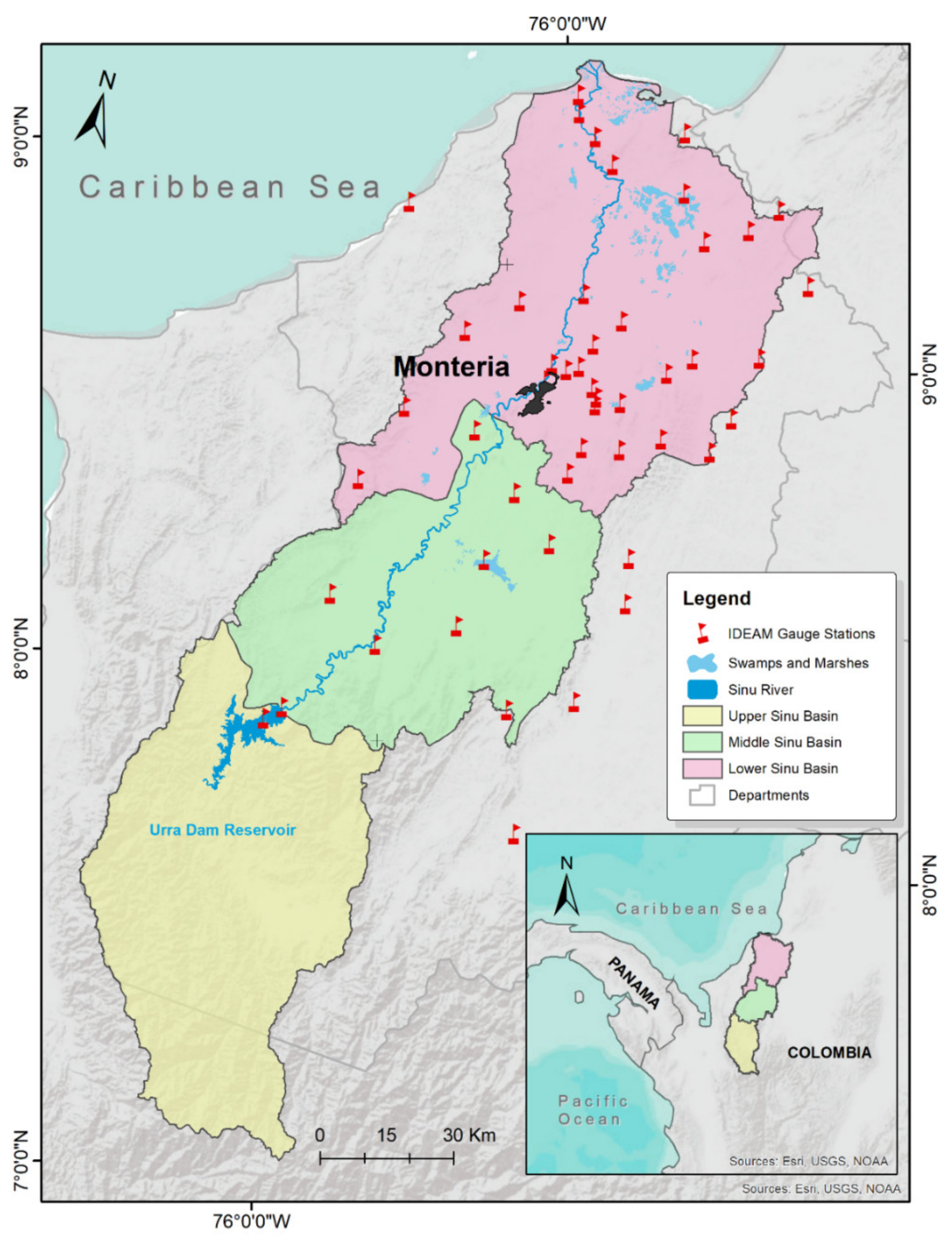
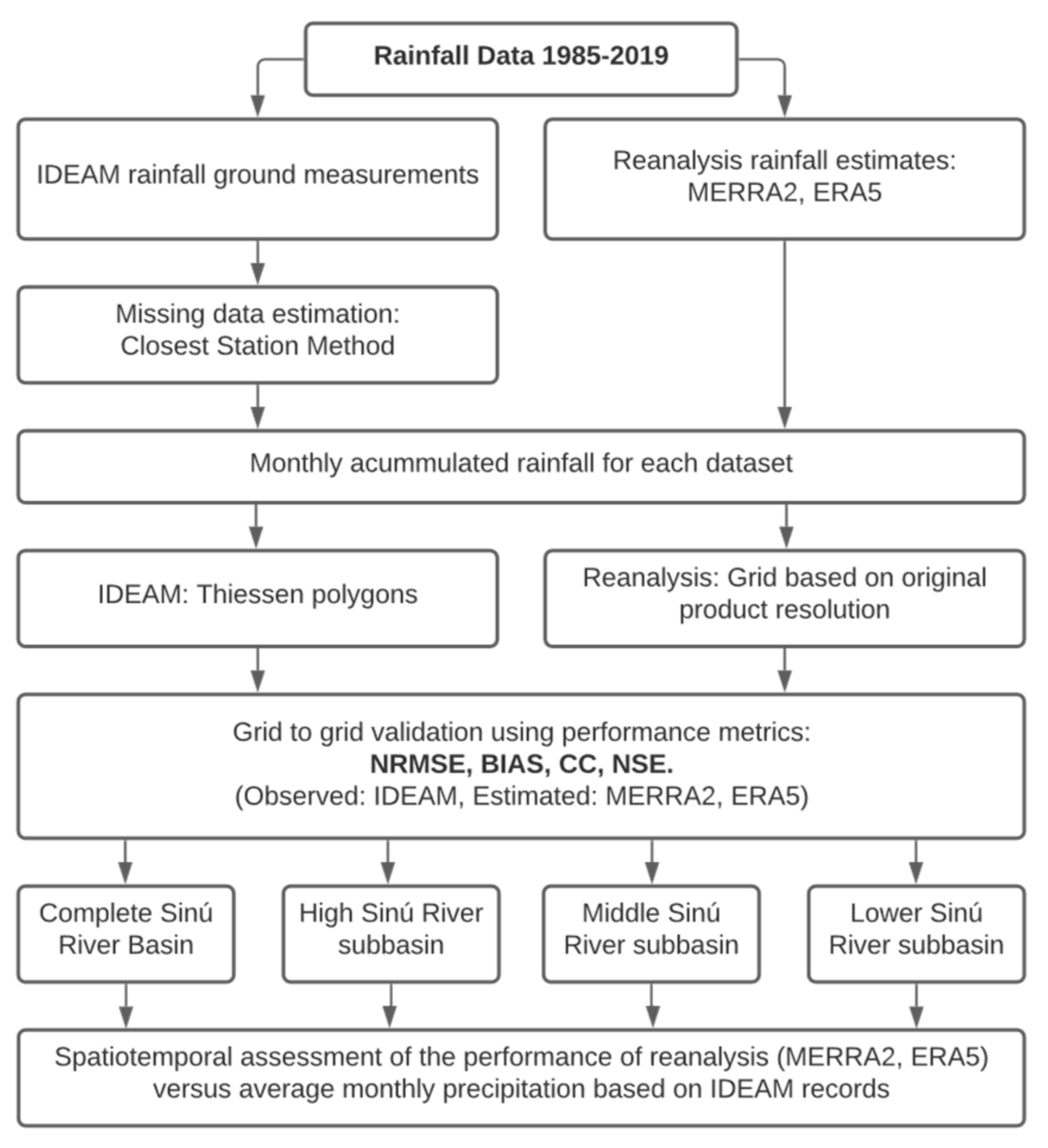
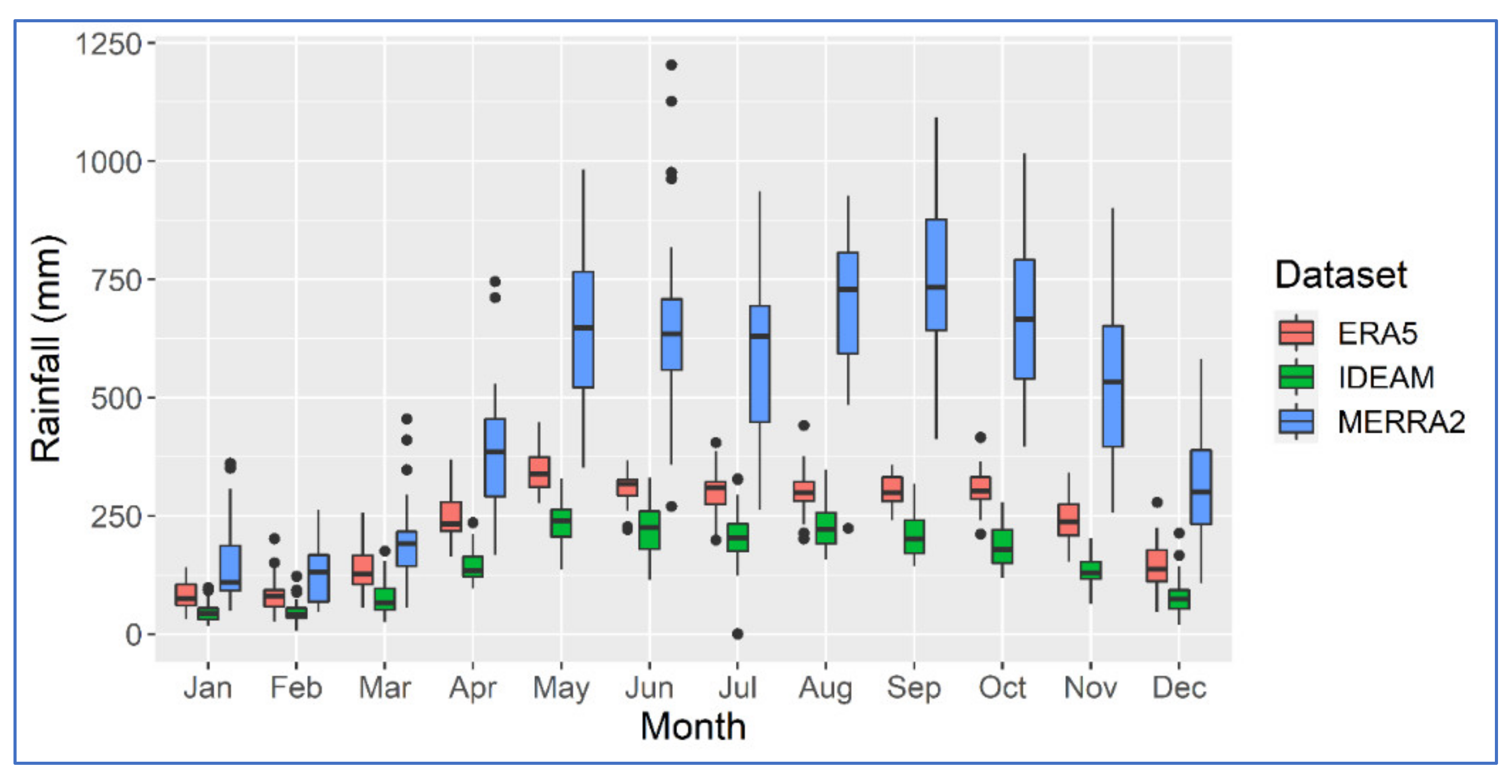
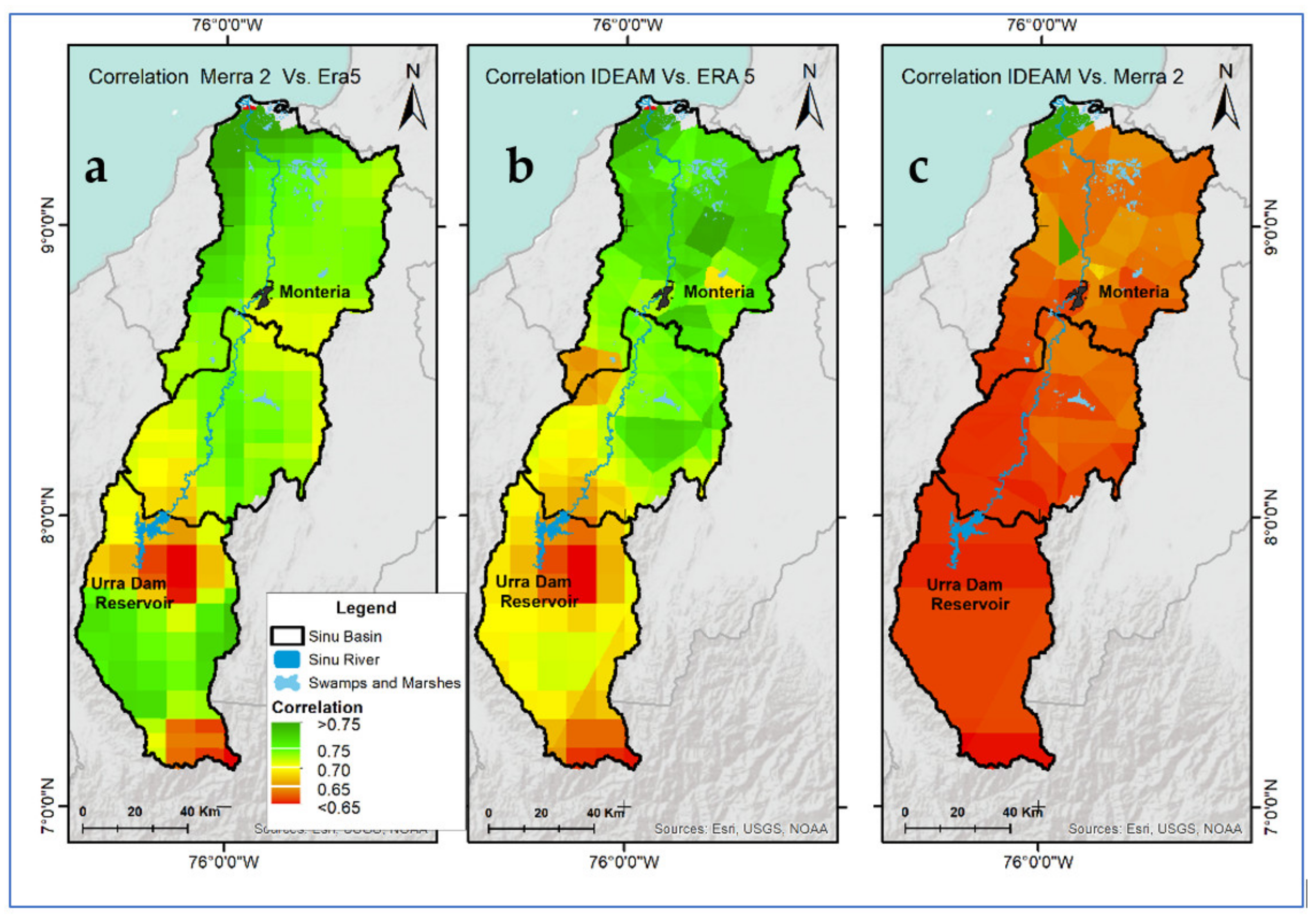
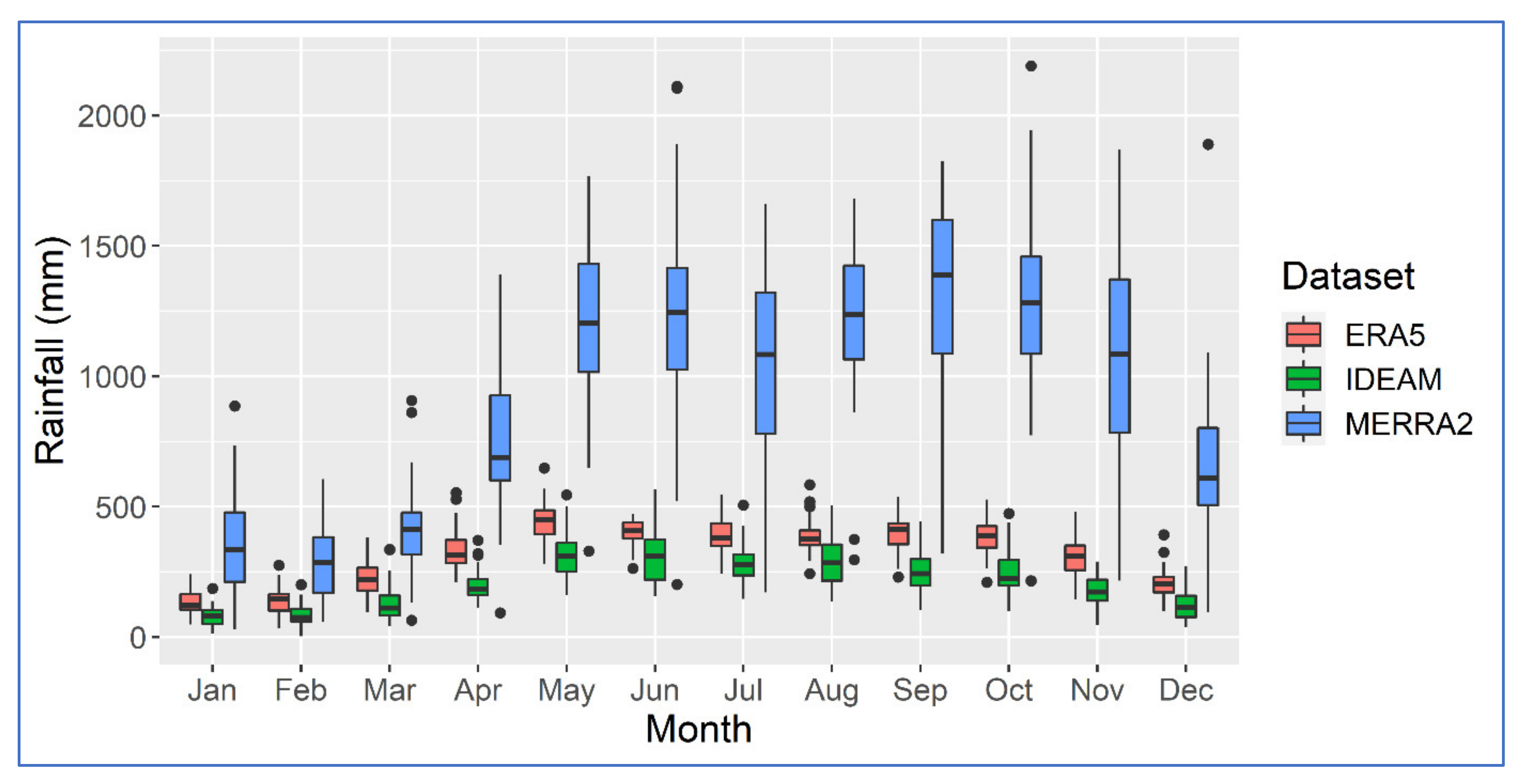
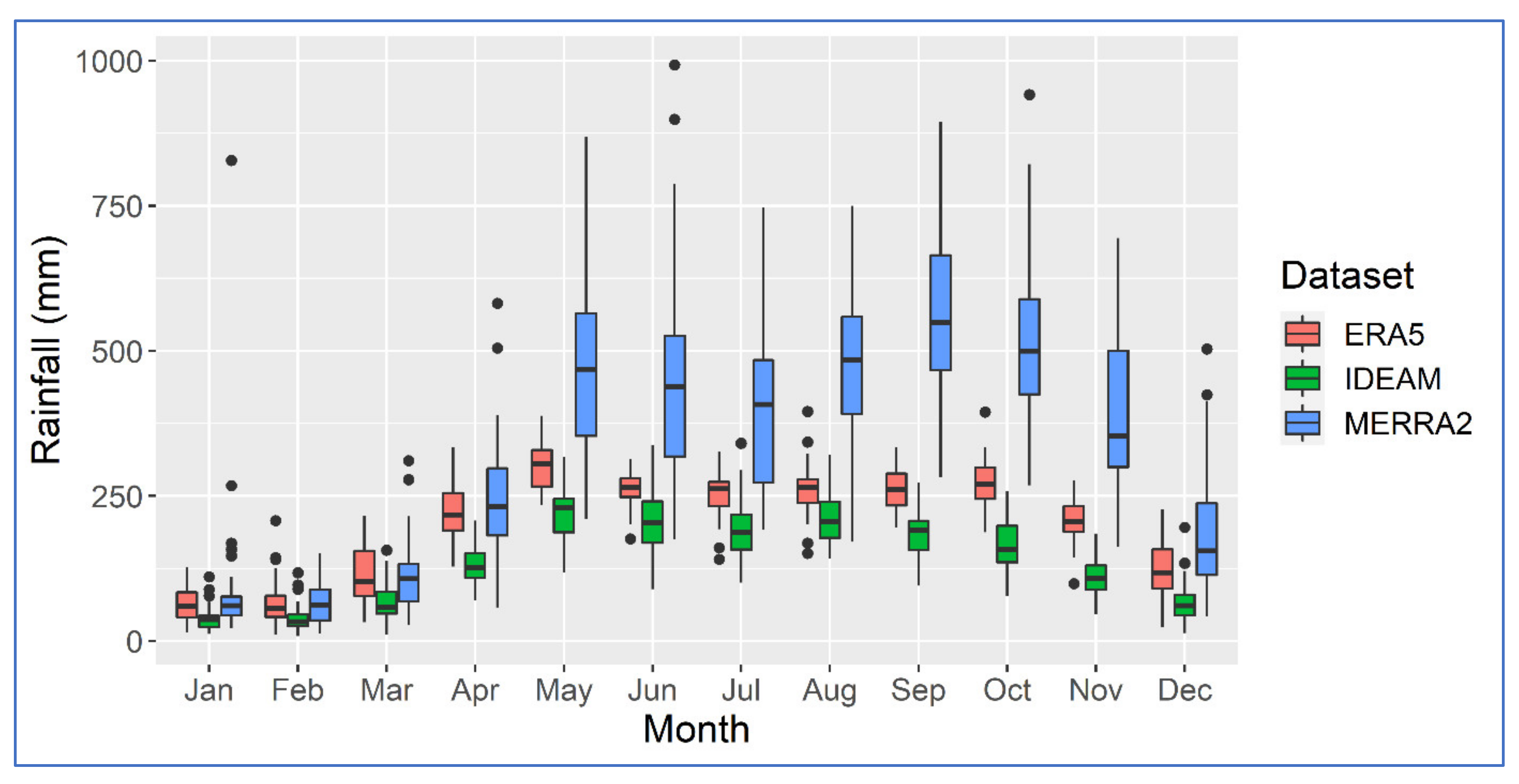
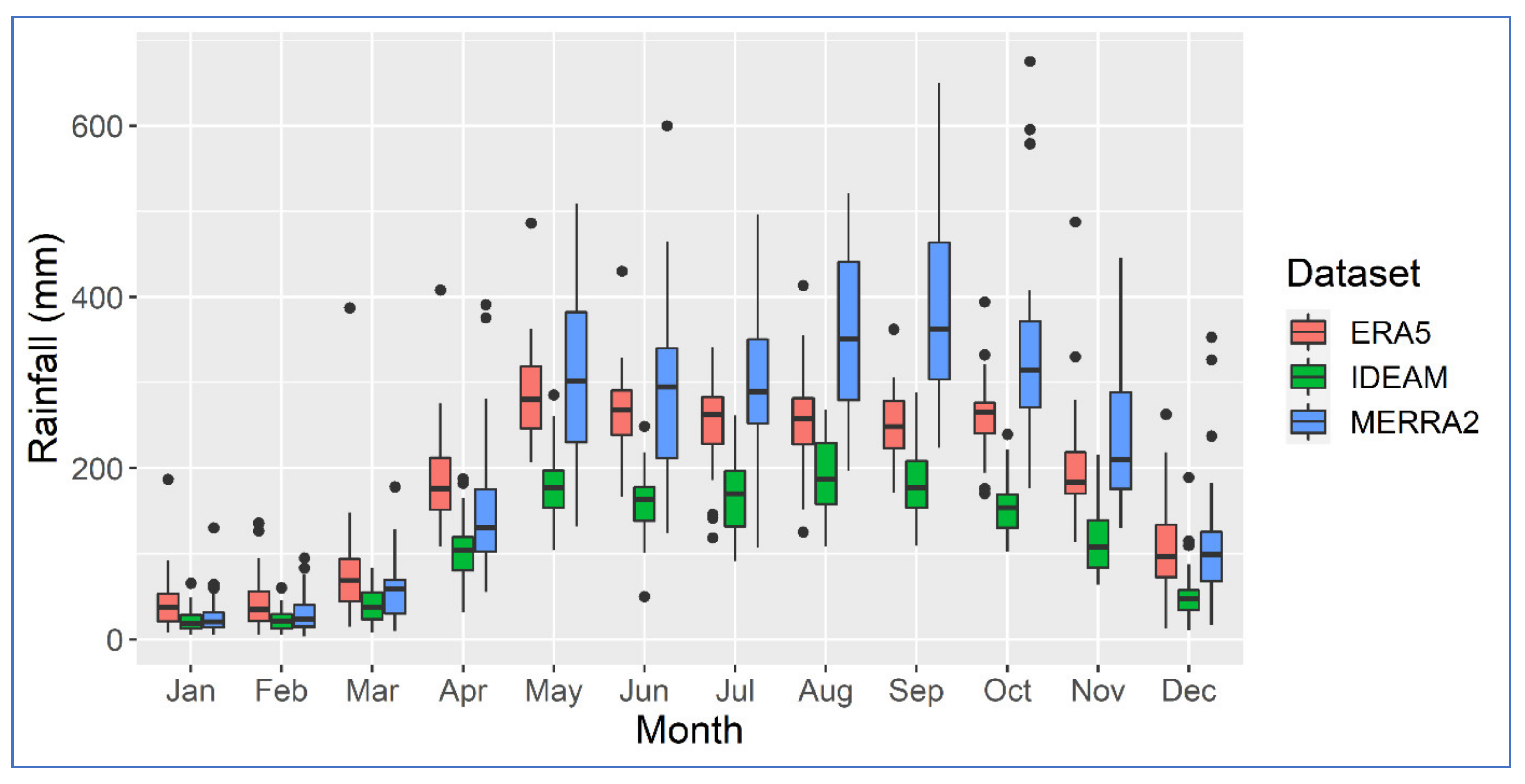
| Time Scale | OBSERVED: IDEAM vs. ESTIMATES: MERRA2 | OBSERVED: IDEAM vs. ESTIMATES: ERA5 | ||||||
|---|---|---|---|---|---|---|---|---|
| ρS | NRMSE | BIAS | NSE | ρS | NRMSE | BIAS | NSE | |
| Jan | 0.132 | 2.889 | 2.303 | −41.843 | 0.528 | 0.942 | 0.765 | −3.553 |
| Feb | 0.317 | 2.268 | 1.862 | −20.536 | 0.632 | 0.924 | 0.733 | −2.576 |
| Mar | 0.427 | 1.898 | 1.597 | −17.209 | 0.816 | 0.978 | 0.846 | −3.841 |
| Apr | 0.590 | 1.836 | 1.655 | −53.417 | 0.519 | 0.778 | 0.720 | −8.776 |
| May | −0.037 | 1.879 | 1.732 | −105.142 | 0.094 | 0.516 | 0.450 | −7.000 |
| Jun | 0.373 | 2.142 | 1.969 | −86.448 | −0.121 | 0.488 | 0.410 | −3.541 |
| Jul | 0.331 | 2.039 | 1.881 | −50.935 | 0.243 | 0.566 | 0.462 | −2.997 |
| Aug | 0.070 | 2.124 | 2.020 | −95.291 | 0.334 | 0.387 | 0.309 | −2.197 |
| Sep | −0.141 | 2.794 | 2.658 | −186.425 | 0.158 | 0.524 | 0.469 | −5.580 |
| Oct | −0.271 | 2.831 | 2.657 | −158.160 | 0.122 | 0.692 | 0.629 | −8.499 |
| Nov | 0.210 | 3.381 | 3.115 | −216.470 | 0.565 | 0.851 | 0.808 | −12.765 |
| Dec | 0.503 | 3.179 | 2.917 | −41.152 | 0.753 | 0.868 | 0.798 | −2.141 |
| Annual | 0.378 | 2.232 | 2.176 | −446.237 | 0.405 | 0.560 | 0.544 | −27.187 |
| Complete | 0.536 | 2.538 | 2.128 | −16.956 | 0.633 | 0.661 | 0.519 | −0.219 |
| Time Scale | OBSERVED: IDEAM vs. ESTIMATES: MERRA2 | OBSERVED: IDEAM vs. ESTIMATES: ERA5 | ||||||
|---|---|---|---|---|---|---|---|---|
| ρS | NRMSE | BIAS | NSE | ρS | NRMSE | BIAS | NSE | |
| Jan | 0.047 | 4.380 | 3.577 | −85.102 | 0.381 | 0.923 | 0.716 | −2.827 |
| Feb | 0.345 | 3.205 | 2.706 | −38.501 | 0.591 | 0.882 | 0.711 | −1.992 |
| Mar | 0.532 | 2.650 | 2.340 | −27.962 | 0.514 | 0.985 | 0.814 | −3.000 |
| Apr | 0.464 | 2.993 | 2.730 | −101.392 | 0.251 | 0.808 | 0.646 | −6.465 |
| May | 0.051 | 2.950 | 2.753 | −103.291 | −0.271 | 0.576 | 0.339 | −2.972 |
| Jun | 0.139 | 3.318 | 3.051 | −112.184 | −0.264 | 0.504 | 0.288 | −1.614 |
| Jul | 0.032 | 2.990 | 2.705 | −128.263 | −0.235 | 0.541 | 0.326 | −3.225 |
| Aug | −0.077 | 3.370 | 3.174 | −107.743 | 0.232 | 0.507 | 0.296 | −1.464 |
| Sep | 0.099 | 4.476 | 4.252 | −234.409 | 0.218 | 0.682 | 0.576 | −4.470 |
| Oct | −0.122 | 4.552 | 4.279 | −165.530 | −0.005 | 0.720 | 0.516 | −3.165 |
| Nov | 0.338 | 5.554 | 5.140 | −293.861 | 0.339 | 0.919 | 0.749 | −7.076 |
| Dec | 0.347 | 4.885 | 4.296 | −98.837 | 0.557 | 0.802 | 0.624 | −1.692 |
| Annual | 0.258 | 3.491 | 3.384 | −532.402 | 0.045 | 0.564 | 0.514 | −12.914 |
| Complete | 0.489 | 3.968 | 3.384 | −53.797 | 0.566 | 0.694 | 0.514 | −0.675 |
| Time Scale | OBSERVED: IDEAM vs. ESTIMATES: MERRA2 | OBSERVED: IDEAM vs. ESTIMATES: ERA5 | ||||||
|---|---|---|---|---|---|---|---|---|
| ρS | NRMSE | BIAS | NSE | ρS | NRMSE | BIAS | NSE | |
| Jan | 0.175 | 3.673 | 1.361 | −44.248 | 0.520 | 0.920 | 0.633 | −1.836 |
| Feb | 0.215 | 1.191 | 0.703 | −2.920 | 0.498 | 1.027 | 0.634 | −1.916 |
| Mar | 0.494 | 1.186 | 0.740 | −5.146 | 0.775 | 0.910 | 0.737 | −2.619 |
| Apr | 0.554 | 1.131 | 0.887 | −15.945 | 0.507 | 0.785 | 0.714 | −7.158 |
| May | 0.001 | 1.426 | 1.195 | −45.083 | 0.007 | 0.491 | 0.398 | −4.463 |
| Jun | 0.356 | 1.502 | 1.244 | −31.088 | 0.029 | 0.398 | 0.277 | −1.254 |
| Jul | 0.084 | 1.323 | 1.079 | −27.105 | 0.144 | 0.458 | 0.319 | −2.371 |
| Aug | 0.138 | 1.379 | 1.252 | −35.340 | 0.138 | 0.359 | 0.215 | −1.459 |
| Sep | −0.104 | 2.239 | 2.061 | −109.419 | 0.100 | 0.511 | 0.433 | −4.744 |
| Oct | −0.176 | 2.362 | 2.137 | −75.382 | 0.080 | 0.734 | 0.643 | −6.385 |
| Nov | 0.362 | 2.849 | 2.548 | −99.749 | 0.415 | 0.938 | 0.885 | −9.921 |
| Dec | 0.498 | 2.196 | 1.789 | −16.575 | 0.700 | 0.932 | 0.836 | −2.166 |
| Annual | 0.330 | 1.518 | 1.453 | −253.366 | 0.280 | 0.508 | 0.480 | −27.440 |
| Complete | 0.515 | 1.940 | 1.453 | −10.717 | 0.631 | 0.627 | 0.480 | −0.222 |
| Time Scale | OBSERVED: IDEAM vs. ESTIMATES: MERRA2 | OBSERVED: IDEAM vs. ESTIMATES: ERA5 | ||||||
|---|---|---|---|---|---|---|---|---|
| ρS | NRMSE | BIAS | NSE | ρS | NRMSE | BIAS | NSE | |
| Jan | 0.326 | 0.986 | 0.330 | −1.808 | 0.455 | 1.755 | 1.002 | −7.884 |
| Feb | 0.270 | 1.021 | 0.365 | −2.898 | 0.528 | 1.620 | 0.974 | −8.821 |
| Mar | 0.485 | 0.966 | 0.485 | −2.499 | 0.706 | 1.666 | 0.995 | −9.397 |
| Apr | 0.430 | 0.758 | 0.402 | −4.188 | 0.641 | 0.888 | 0.765 | −6.117 |
| May | 0.390 | 0.897 | 0.718 | −16.290 | 0.372 | 0.665 | 0.584 | −8.485 |
| Jun | 0.163 | 1.043 | 0.812 | −19.665 | 0.331 | 0.745 | 0.678 | −9.542 |
| Jul | 0.084 | 1.323 | 1.079 | −27.105 | 0.144 | 0.458 | 0.319 | −2.371 |
| Aug | 0.068 | 1.041 | 0.890 | −21.645 | 0.443 | 0.456 | 0.344 | −3.339 |
| Sep | −0.126 | 1.289 | 1.096 | −27.838 | 0.096 | 0.469 | 0.359 | −2.817 |
| Oct | −0.039 | 1.375 | 1.150 | −48.663 | 0.487 | 0.741 | 0.692 | −13.433 |
| Nov | 0.514 | 1.248 | 1.086 | −11.841 | 0.427 | 0.935 | 0.783 | −6.211 |
| Dec | 0.556 | 1.506 | 1.099 | −5.090 | 0.732 | 1.182 | 1.007 | −2.754 |
| Annual | 0.324 | 0.924 | 0.863 | −57.858 | 0.647 | 0.667 | 0.604 | −29.709 |
| Complete | 0.572 | 1.259 | 0.863 | −3.153 | 0.669 | 0.778 | 0.604 | −0.586 |
Publisher’s Note: MDPI stays neutral with regard to jurisdictional claims in published maps and institutional affiliations. |
© 2021 by the authors. Licensee MDPI, Basel, Switzerland. This article is an open access article distributed under the terms and conditions of the Creative Commons Attribution (CC BY) license (https://creativecommons.org/licenses/by/4.0/).
Share and Cite
Vega-Durán, J.; Escalante-Castro, B.; Canales, F.A.; Acuña, G.J.; Kaźmierczak, B. Evaluation of Areal Monthly Average Precipitation Estimates from MERRA2 and ERA5 Reanalysis in a Colombian Caribbean Basin. Atmosphere 2021, 12, 1430. https://doi.org/10.3390/atmos12111430
Vega-Durán J, Escalante-Castro B, Canales FA, Acuña GJ, Kaźmierczak B. Evaluation of Areal Monthly Average Precipitation Estimates from MERRA2 and ERA5 Reanalysis in a Colombian Caribbean Basin. Atmosphere. 2021; 12(11):1430. https://doi.org/10.3390/atmos12111430
Chicago/Turabian StyleVega-Durán, Jean, Brigitte Escalante-Castro, Fausto A. Canales, Guillermo J. Acuña, and Bartosz Kaźmierczak. 2021. "Evaluation of Areal Monthly Average Precipitation Estimates from MERRA2 and ERA5 Reanalysis in a Colombian Caribbean Basin" Atmosphere 12, no. 11: 1430. https://doi.org/10.3390/atmos12111430
APA StyleVega-Durán, J., Escalante-Castro, B., Canales, F. A., Acuña, G. J., & Kaźmierczak, B. (2021). Evaluation of Areal Monthly Average Precipitation Estimates from MERRA2 and ERA5 Reanalysis in a Colombian Caribbean Basin. Atmosphere, 12(11), 1430. https://doi.org/10.3390/atmos12111430








